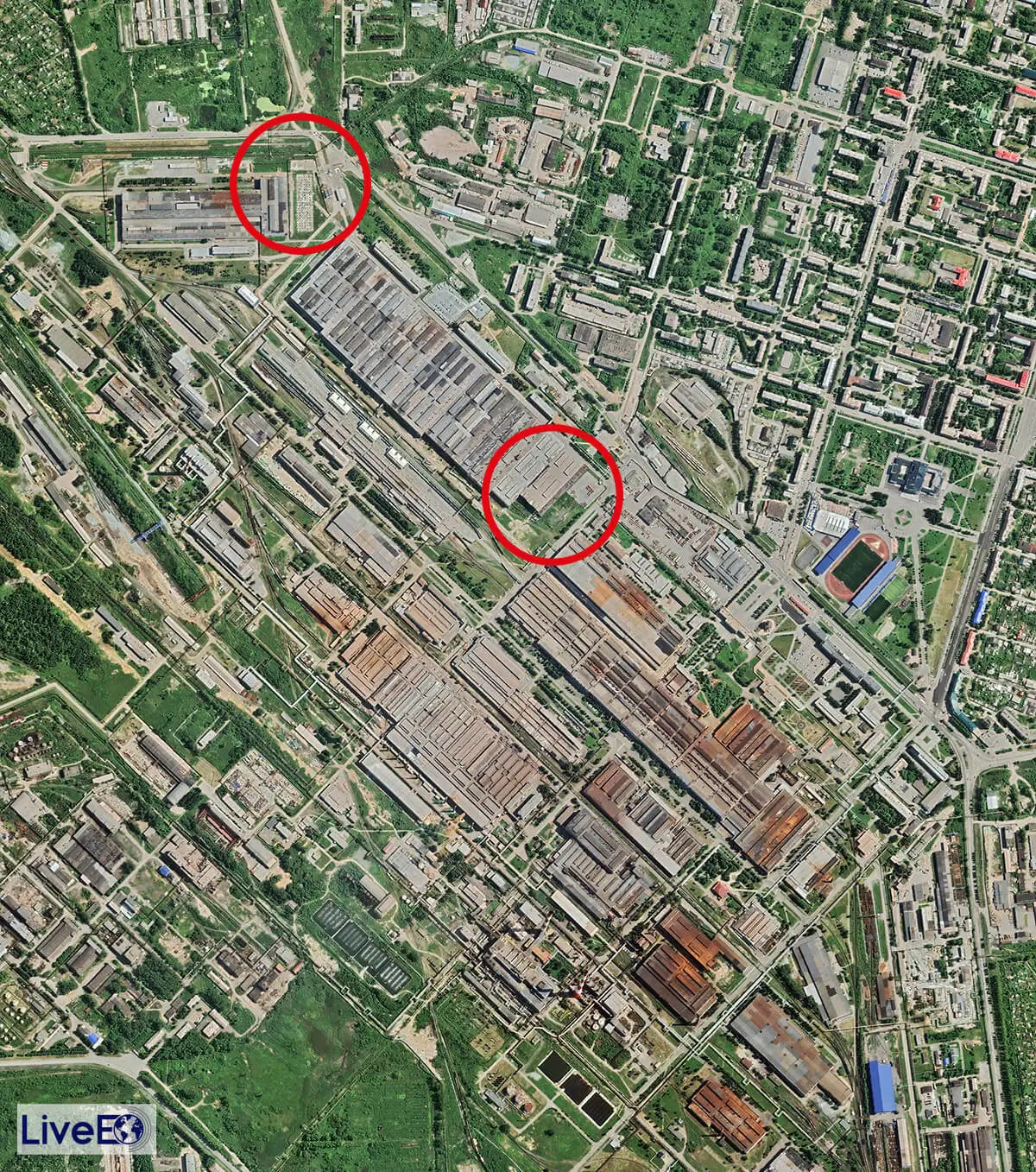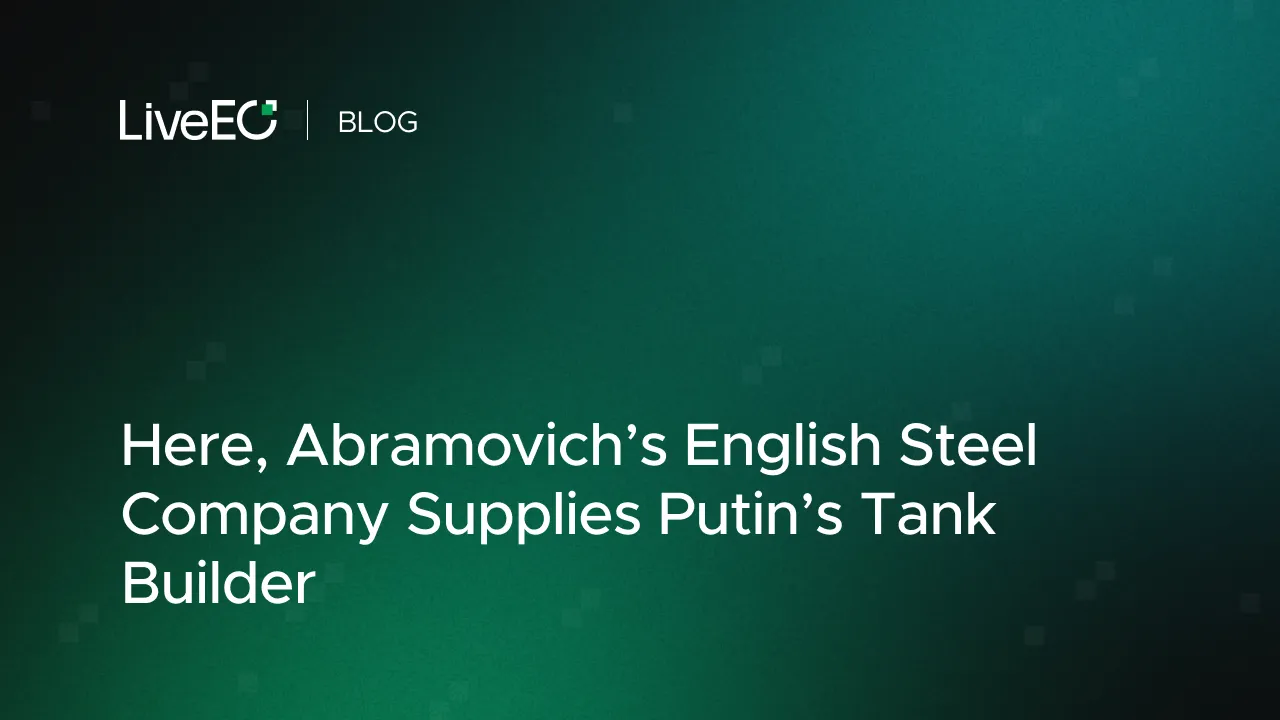The Russian company Uralvagonzavod is the largest tank manufacturer in the world, but also builds railroad cars. Satellite images show that the plant is located right next to a steel mill owned by the London-based Evraz Group. Does the metal for the weapons also come from there?
“Economy from above” is a collaboration between WirtschaftsWoche and LiveEO. This is a translation of the original article written in German by “Thomas Stölzel“. Access the original article here.
Just a few days ago, Russia’s state-owned tank builder Uralvagonzavod in the industrial city of Nizhny Tagil sent a train on its way, packed with brand new T-90M main battle tanks, rolling toward the front lines of Vladimir Putin’s war of aggression in Ukraine. According to Russian media, marching music played on departure, and a clergyman blessed the war machine. Uralvagonzavod is considered the world’s largest manufacturer of battle tanks, employing some 30,000 people.
Recent satellite imagery indicates close ties between the Russian tank builder and Evraz, an international steel company that operates a huge steel mill in Nizhny Tagil. Evraz is a British company and listed on the London Stock Exchange. The group, which employs 70,000 people around the globe, is backed by Russian oligarchs Roman Abramovich and Alexander Abramov, who are now subject to sanctions. The British government recently described the company as “strategically significant for the Russian government”.
The Tank City of Nizhny Tagil

The fact that Evraz has supplied metal to Uralvagonzavod in recent years is clear from the company’s annual reports and communications. According to media reports, the British government suspects that the company also supplied steel for tank production. When asked by WirtschaftsWoche, Evraz denied that it had supplied the Russian military with steel that could be used for military purposes. The products would only be used for civilian purposes. Uralvagonzavod produces not only tanks at the site, but also railroad cars and machinery for road construction.
However, LiveEO’s satellite images make it clear that the British government’s suspicions are quite reasonable. Not only are the factories of the two companies located in close proximity to each other and connected by railroad tracks. The Soviet Union had built up the factories in Nizhny Tagil as a huge interconnected industrial complex. The steelworks supplied tank production as early as the 1940s. The Warsaw Institute, a think tank specializing in security policy, had told the British newspaper Daily Mail in March that the steel company’s materials were used for tank production before the Ukrainian war.

30.04.2022: The Evraz steel mill (bottom) is located here right next to the tank manufacturer Uralvagonzavod (top).
Images: LiveEO/Sentinel
The footage also makes it clear that tank production at Uralvagonzavod can hardly be separated from the production of railroad cars and construction machinery. According to the footage, this all takes place in the huge halls of Uralvagonzavod in the east of the city, which has a population of around 360,000.
For example, a deeper analysis of satellite imagery shows around 2010 a kind of parking lot at the northern end of the plant’s premises, where hundreds of orange excavators and green construction vehicles from Uralvagonzavod’s production are parked. Since about 2014, however, the lot has been used primarily to park tanks produced on site. However, some of the war equipment may also be stored hidden from spy satellites in the production halls. The railroadtracks lead directly into them.
{{inline}}
The fact that Uralvagonzavod’s various products can hardly be separated from one another is also made clear by a photograph taken in October 2021, which shows a marshalling yard to the north of the factory site, where there are apparently railroad cars for bulk goods newly built or refurbished by Uralvagonzavod, and next to them five cars loaded with battle tanks.
In photos taken in 2020, there also appear to be tanks loaded in the station. However, they cannot be clearly identified here because they are presumably covered with fabric tarpaulins.

However, Uralvagonzavod produces not only the T-90 tank, which was introduced back in the 1990s, but recently also the T-14 Armata. Putin’s new super tank is supposed to be a response to the German Leopard 2, long considered the best tank in the world. But when Russia rolled out the T-14 at a military parade on May 7, 2015, one of the prototypes broke down, probably with transmission damage. Since then, the problems have continued.
Putin had originally ordered 2300 units. The first were to be delivered in 2020. Now the date has been postponed to 2025. And according to defense circles, the number of units has also been reduced to several hundred. Whether the tanks most recently parked at Uralvagonzavod are T-14s or T-90s is difficult to determine from the satellite images.

.jpeg)
The fact that Uralvagonzavod’s business nevertheless seems to be going well can also be assumed because one of the production halls from Soviet times has been expanded in recent years and an office building has been added. In addition, a test area for tanks in the south of the city has been redesigned. Here, tank builders can chase their weapons over an obstacle course that includes humps, tight turns and a water hole. There is also a rectangular pond where bridge-building tanks can be tested.
The entire facility is about ten kilometers long. Satellite imagery reveals numerous yellow-painted vehicles scattered around the site, apparently being used as targets for live-fire tests. For example, some appear to be largely intact in older images, but later appear to be destroyed. From time to time, tanks can be seen on the site in the footage. According to Russian media, the T-90M’s cannon has a range of about five kilometers.
Although it is difficult to prove from space how close or loose the relationship between Uralvagonzavod and Evraz really is, the British government sanctioned the steelmaker in early May. British citizens have since been prohibited from doing business with the company. Evraz shares were already suspended from trading on the London Stock Exchange in March.
Ukrainian troops, meanwhile, have destroyed several hundred Russian tanks in battles since the end of February, according to media reports. Above all, portable American anti-tank weapons and armor-piercing suicide drones are giving Putin’s army and the war machine from Nizhny Tagil a hard time. In the meantime, Moscow apparently has to send Soviet tanks that are already 50 years old to the front. The attackers are therefore likely to urgently need the supplies from Nizhny Tagil.
About LiveEO: Using Satellite Data & AI, we are revolutinizing the way companies monitor their supply chains for deforestation. Check out our innovative solution.







